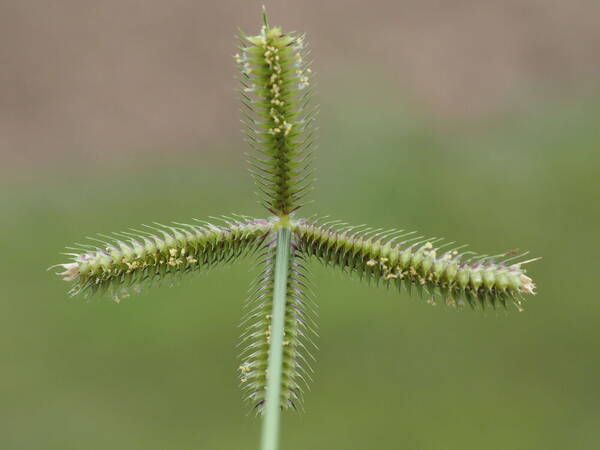Info
Subfamily: Chloridoideae
Genus etymology: Dactyloctenium = "Finger comb" [Greek] refering to the inflorescence shape
Species etymology: aegyptium = from Egypt, although this is found across the entirity of Africa and tropical Asia
Photosynthetic type: C4 (warm season)
Nativity: naturalized - intentional
First recorded in Hawaiʻi: 1908
Map


Inflorescence



Plant




Habit




Spikelets


Description
Slender to moderately robust spreading annual; culms up to 70(–100) cm. high, usually geniculately ascending and rooting at the lower nodes, frequently shortly stoloniferous and mat-forming, less often erect. Leaf-blades flat, 3–25 cm. long, 2.5–7.5(–12) mm. wide, papillose-hispid especially along the margins. Inflorescence composed of (1–)3–9 linear to narrowly oblong spikes 1.2–6.5 cm. long, ascending or often radiating horizontally from the top of the culm. Spikelets 3–4-flowered, broadly ovate, 3.5–4.5 mm. long; glumes subequal, 1.5–2.2 mm. long, the lower lanceolate in profile with a thick scabrid keel, the upper elliptic to narrowly obovate in profile, the smooth keel extended into a stout divergent scabrid awn 1/2–2 times as long as the glume; lemmas narrowly ovate to ovate in profile, 2.6–4 mm. long, the keel gibbous, concave and scabrid above the middle and often extended into a stout cusp or mucro up to 1 mm. long; palea-keels winged or unwinged; anthers 0.25–0.8 mm. long. Grain ± 1 mm. long, broadly obovate to obtriangular in profile, transversely rugose.
(Description source: Clayton, W.D. 1970. Flora of Tropical East Africa. Gramineae (Part 1). Crown Agents for Oversea Governments and Administrations, London. 176 pp. )
Annual, often stoloniferous and mat-forming, up to 70(–100) cm high; leaves papillose-hispid, especially on the margins. Inflorescence comprising (1–)3–9 linear to narrowly oblong racemes 1.2–6.5(–7.5) cm long, these ascending or radiating. Spikelets broadly ovate, 3.5–4.5 mm long; glumes subequal, 1.5–2.2 mm long, the upper with an awn from half as long to as long as the body; lemmas narrowly ovate in profile, 2.6–4 mm long, acute and with a stout cusp or mucro up to 1 mm long; anthers 0.25–0.8 mm long. Grain transversely rugose.
(Description source: Cope, T.A, (1995) Flora Somalia, Vol 4. Royal Botanical Gardens, Kew, London. 312 pp. )
Slender to moderately robust spreading annual; culms up to 70(100) cm tall, usually geniculately ascending and rooting from the lower nodes, often shortly stoloniferous and mat-forming, less often erect; leaf laminas 3–25 cm × 2.5–7.5(12) mm, flat, papillose-hispid especially along the margins.Racemes (1)3–9, 1.2–6.75 cm long, linear to narrowly oblong, ascending or radiating.Spikelets 3.5–4.5 mm long, broadly ovate, 3–4-flowered; glumes subequal, 1.5–2.2 mm long, the inferior lanceolate in profile with a thick scabrid keel, the superior elliptic to narrowly obovate in profile, the smooth keel extended into a stout divergent scabrid awn 0.5–2 times as long as the body; lemmas 2.6–4 mm long, narrowly ovate to ovate in profile, the keels gibbous, concave and scabrid above the middle and often extended into a stout cusp or mucro up to 1 mm long; palea keels winged or wingless; anthers 0.25–0.8 mm long.Caryopsis c. 1 mm long, broadly obovate to obtriangular, transversely rugose.
(Description source: Pope, G.V. (ed). 1999. Flora Zambesiaca. Volume 10. Part 2. Kew, London. 261 pp. )
Plants tufted annuals or short¬lived, shortly stoloniferous perennials. Culms 10-35(100) cm, usually geniculately ascending and rooting at the lower nodes. Sheaths keeled, with papillose-based hairs distally; ligules 0.5-1.5 mm, membranous, ciliate; blades 5-22 cm long, 2-8(12) mm wide, with papillose-based hairs. Panicle branches (1)2-6(8), 1.5-6 cm, only the first few spikelets in contact with the spikelets of adjacent branches; branch axes extending beyond the spikelets for 1-6 mm. Spikelets 3-4.5 mm long, about 3 mm wide. Glumes 1.5-2 mm; lower glumes ovate, acute; upper glumes oblong elliptic, obtuse, awned, awns 1-2.5 mm; lemmas 2.5-3.5 mm, ovate, midveins extended into curved, 0.5-1 mm awns; paleas about as long as the lemmas; anthers 0.5-0.8 mm, pale yellow. Seeds cuboid, about 1 mm long and wide, transversely rugose, light tan to reddish-brown. 2n = 20, 36, 40, 45, 48.
(Description source: Barkworth, M.E., Capels, K.M., Long, S. & Piep, M.B. (eds.) 2003. Flora of North America, north of Mexico. Volume 25. Magnoliophyta: Commelinidae (in part): Poaceae, Part 2. Oxford University Press, New York. 783 pp. http://floranorthamerica.org/Dactyloctenium_aegyptium )
Slender to moderately robust, spreading annuals; culms 70-100 cm tall, usually geniculately ascending and rooting at lower nodes, usually stoloniferous and mat-forming. Sheaths 2.5-4 cm long, compressed, glabrous or with a few bulbous-based hairs on the keel; ligule a narrow fimbriate membrane; blades flat, 3-25 cm long, 2.5-7.5 (-12) mm wide, papillose-hispid, especially along margins. Inflorescences composed of (1-)3-9 linear to narrowly oblong spikes 1.2-6.5 cm long, ascending to radiating horizontally from top of culm; spikelets 3- 4-flowered, broadly ovate, 3.5-4.5 mm long; glumes subequal, 1.5-2.2 mm long, first glume lanceolate in profile, keel thick, - scabrid, second glume elliptic to narrowly obovate in profile, keel smooth, prolonged into a stout, divergent, scabrid awn 0.5-2 times as long as the glume; lemmas narrowly ovate to ovate in profile, 2.6-4 mm long, keel gibbous, concave and scabrid above the middle and usually prolonged into a stout cusp or mucro up to 1 mm long; palea keels + winged. Caryopsis broadly obovate to triangular, ca. 1 mm long, transversely rugose. [2n = 18, 20, 22, 23, 27, 34, 36, 38, 40, 44-46, 48, 52.]
(Description source: O’Connor, P.J. 1990. Poaceae, pp. 1481–1604. In: Wagner W.L., Herbst D.R. & Sohmer S.H. (eds.)., Manual of the flowering plant of Hawaiʻi. Vol. 2. University of Hawaii Press & Bishop Museum Press, Honolulu )